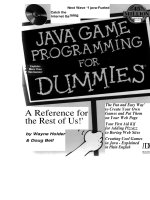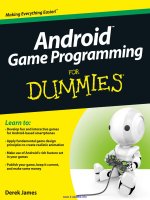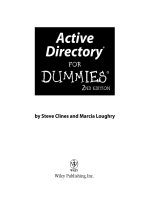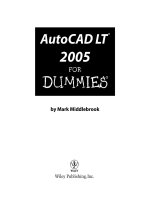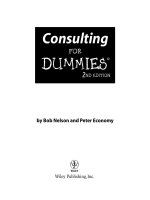access vba programming for dummies (isbn - 0764574116)
Bạn đang xem bản rút gọn của tài liệu. Xem và tải ngay bản đầy đủ của tài liệu tại đây (8.01 MB, 410 trang )
by Alan Simpson
Access VBA
Programming
FOR
DUMmIES
‰
00a_574116_ffirs.qxd 7/27/04 9:03 PM Page i
00a_574116_ffirs.qxd 7/27/04 9:03 PM Page iv
by Alan Simpson
Access VBA
Programming
FOR
DUMmIES
‰
00a_574116_ffirs.qxd 7/27/04 9:03 PM Page i
Access VBA Programming For Dummies
®
Published by
Wiley Publishing, Inc.
111 River Street
Hoboken, NJ 07030-5774
www.wiley.com
Copyright © 2004 by Wiley Publishing, Inc., Indianapolis, Indiana
Published by Wiley Publishing, Inc., Indianapolis, Indiana
Published simultaneously in Canada
No part of this publication may be reproduced, stored in a retrieval system or transmitted in any form or
by any means, electronic, mechanical, photocopying, recording, scanning or otherwise, except as permitted
under Sections 107 or 108 of the 1976 United States Copyright Act, without either the prior written permis-
sion of the Publisher, or authorization through payment of the appropriate per-copy fee to the Copyright
Clearance Center, 222 Rosewood Drive, Danvers, MA 01923, (978) 750-8400, fax (978) 646-8600. Requests to
the Publisher for permission should be addressed to the Legal Department, Wiley Publishing, Inc., 10475
Crosspoint Blvd., Indianapolis, IN 46256, (317) 572-3447, fax (317) 572-4355, e-mail: brandreview@
wiley.com.
Trademarks: Wiley, the Wiley Publishing logo, For Dummies, the Dummies Man logo, A Reference for the
Rest of Us!, The Dummies Way, Dummies Daily, The Fun and Easy Way, Dummies.com, and related trade
dress are trademarks or registered trademarks of John Wiley & Sons, Inc. and/or its affiliates in the United
States and other countries, and may not be used without written permission. All other trademarks are the
property of their respective owners. Wiley Publishing, Inc., is not associated with any product or vendor
mentioned in this book.
LIMIT OF LIABILITY/DISCLAIMER OF WARRANTY: THE PUBLISHER AND THE AUTHOR MAKE NO REP-
RESENTATIONS OR WARRANTIES WITH RESPECT TO THE ACCURACY OR COMPLETENESS OF THE
CONTENTS OF THIS WORK AND SPECIFICALLY DISCLAIM ALL WARRANTIES, INCLUDING WITHOUT
LIMITATION WARRANTIES OF FITNESS FOR A PARTICULAR PURPOSE. NO WARRANTY MAY BE CRE-
ATED OR EXTENDED BY SALES OR PROMOTIONAL MATERIALS. THE ADVICE AND STRATEGIES
CONTAINED HEREIN MAY NOT BE SUITABLE FOR EVERY SITUATION. THIS WORK IS SOLD WITH THE
UNDERSTANDING THAT THE PUBLISHER IS NOT ENGAGED IN RENDERING LEGAL, ACCOUNTING, OR
OTHER PROFESSIONAL SERVICES. IF PROFESSIONAL ASSISTANCE IS REQUIRED, THE SERVICES OF A
COMPETENT PROFESSIONAL PERSON SHOULD BE SOUGHT. NEITHER THE PUBLISHER NOR THE
AUTHOR SHALL BE LIABLE FOR DAMAGES ARISING HEREFROM. THE FACT THAT AN ORGANIZATION
OR WEBSITE IS REFERRED TO IN THIS WORK AS A CITATION AND/OR A POTENTIAL SOURCE OF FUR-
THER INFORMATION DOES NOT MEAN THAT THE AUTHOR OR THE PUBLISHER ENDORSES THE
INFORMATION THE ORGANIZATION OR WEBSITE MAY PROVIDE OR RECOMMENDATIONS IT MAY
MAKE. FURTHER, READERS SHOULD BE AWARE THAT INTERNET WEBSITES LISTED IN THIS WORK
MAY HAVE CHANGED OR DISAPPEARED BETWEEN WHEN THIS WORK WAS WRITTEN AND WHEN IT
IS READ.
For general information on our other products and services or to obtain technical support, please contact
our Customer Care Department within the U.S. at 800-762-2974, outside the U.S. at 317-572-3993, or fax
317-572-4002.
Wiley also publishes its books in a variety of electronic formats. Some content that appears in print may
not be available in electronic books.
Library of Congress Control Number: 2004104566
ISBN: 0-7645-7411-6
Manufactured in the United States of America
10 9 8 7 6 5 4 3 2 1
1O/RT/QY/QU/IN
00a_574116_ffirs.qxd 7/27/04 9:03 PM Page ii
About the Author
Alan Simpson is the author of over 90 computer books on databases,
Windows, Web site design and development, programming, and networking.
His books are published throughout the world in over a dozen languages
and have millions of copies. Alan has also taught introductory and advanced
computer programming courses at San Diego State University and the UCSD
Extension. He has served as a consultant on high-technology, education-
oriented projects for the United States Navy and Air Force. Despite that,
Alan has no fancy job title because he has never had a real job.
00a_574116_ffirs.qxd 7/27/04 9:03 PM Page iii
00a_574116_ffirs.qxd 7/27/04 9:03 PM Page iv
Dedication
To Susan, Ashley, and Alec, as always.
Author’s Acknowledgments
Even though only one author’s name appears on the cover, every book
is a team project. This author would like to thank the many people who
contributed to this book. To Matt Wagner and all the folks at Waterside
Productions, a big thanks for helping to make it all happen. Many thanks
to Terry Varveris and Christopher Morris at Wiley for their enduring
patience (and Terry’s relentless friendly reminders). And of course,
thanks to all the people at home for putting up with the neglect while
Daddy cranked out yet another book.
00a_574116_ffirs.qxd 7/27/04 9:03 PM Page v
Publisher’s Acknowledgments
We’re proud of this book; please send us your comments through our online registration form
located at
www.dummies.com/register/.
Some of the people who helped bring this book to market include the following:
Acquisitions, Editorial, and
Media Development
Project Editor: Christopher Morris
Acquisitions Editor: Terri Varveris
Senior Copy Editor: Teresa Artman
Technical Editor: Wiley-Dreamtech India
Pvt Ltd
Editorial Manager: Kevin Kirschner
Media Development Specialist: Angela Denny
Media Development Manager:
Laura VanWinkle
Media Development Supervisor:
Richard Graves
Editorial Assistant: Amanda Foxworth
Cartoons: Rich Tennant,
www.the5thwave.com
Composition
Project Coordinator: Courtney MacIntyre
Layout and Graphics: Andrea Dahl,
Denny Hager, Joyce Haughey,
Michael Kruzil, Lynsey Osborn,
Melanee Prendergast, Jacque Roth,
Heather Ryan, Mary Gillot Virgin
Proofreaders: Laura Albert,
TECHBOOKS Production Services
Indexer: TECHBOOKS Production Services
Publishing and Editorial for Technology Dummies
Richard Swadley, Vice President and Executive Group Publisher
Andy Cummings, Vice President and Publisher
Mary Bednarek, Executive Editorial Director
Mary C. Corder, Editorial Director
Publishing for Consumer Dummies
Diane Graves Steele, Vice President and Publisher
Joyce Pepple, Acquisitions Director
Composition Services
Gerry Fahey, Vice President of Production Services
Debbie Stailey, Director of Composition Services
00a_574116_ffirs.qxd 7/27/04 9:03 PM Page vi
Contents at a Glance
Introduction 1
Part I: Introducing VBA Programming 7
Chapter 1: Where VBA Fits In 9
Chapter 2: Your VBA Toolkit 21
Chapter 3: Jumpstart: Creating a Simple VBA Program 35
Part II: VBA Tools and Techniques 49
Chapter 4: Understanding Your VBA Building Blocks 51
Chapter 5: Controlling Access through VBA 71
Chapter 6: Programming Access Forms 87
Part III: VBA, Recordsets, and SQL 115
Chapter 7: The Scoop on SQL and Recordsets 117
Chapter 8: Putting Recordsets to Work 147
Part IV: Applying VBA in the Real World 173
Chapter 9: Creating Your Own Dialog Boxes 175
Chapter 10: Customizing Lists and Drop-Down Menus 201
Chapter 11: Creating Your Own Functions 241
Chapter 12: Testing and Debugging Your Code 267
Part V: Reaching Out with VBA 295
Chapter 13: Using VBA with Multiple Databases 297
Chapter 14: Integrating with Other Office Applications 317
Part VI: The Part of Tens 349
Chapter 15: Ten Commandments of Writing VBA 351
Chapter 16: Top Ten Nerdy VBA Tricks 357
Chapter 17: (Way More Than) Ten Shortcut Keys 367
Index 371
00b_574116_ftoc.qxd 7/27/04 9:03 PM Page vii
00b_574116_ftoc.qxd 7/27/04 9:03 PM Page viii
Table of Contents
Introduction 1
About This Book 2
Conventions Used in This Book 2
What You’re Not to Read 3
Foolish Assumptions 3
How This Book Is Organized 3
Part I: Introducing VBA Programming 3
Part II: VBA Tools and Techniques 4
Part III: VBA, Recordsets, and SQL 4
Part IV: Applying VBA in the Real World 4
Part V: Reaching Out with VBA 4
Part VI: The Part of Tens 4
Icons Used in This Book 5
Web Site for This Book 5
Where to Go from Here 6
Part I: Introducing VBA Programming 7
Chapter 1: Where VBA Fits In . . . . . . . . . . . . . . . . . . . . . . . . . . . . . . . . . . .9
Taking a Look at Access 10
Understanding VBA 11
Seeing Where VBA Lurks 12
Finding standard modules 13
Finding class modules 13
From VBA to Access 15
Finding Out How VBA Works 17
Discovering VBA procedures 17
Recognizing VBA procedures 18
Chapter 2: Your VBA Toolkit . . . . . . . . . . . . . . . . . . . . . . . . . . . . . . . . . . . .21
Using the Visual Basic Editor 21
Using Project Explorer 23
Using the Properties window 24
Using the Immediate window 25
Using the Code window 26
Referring to Objects from VBA 28
Setting References to Object Libraries 29
Using the Object Browser 30
Searching the Object Library 32
00b_574116_ftoc.qxd 7/27/04 9:03 PM Page ix
Chapter 3: Jumpstart: Creating a Simple VBA Program . . . . . . . . . . . .35
Creating a Standard Module 35
Creating a Procedure 36
Understanding Syntax 38
Getting keyword help 39
Help with arguments 43
About named arguments 45
Modifying Existing Code 46
Copy-and-paste code from the Web 46
Importing standard modules 47
Modifying existing code 48
Part II: VBA Tools and Techniques 49
Chapter 4: Understanding Your VBA Building Blocks . . . . . . . . . . . . .51
Commenting Your Code 52
Understanding VBA Data Types 53
Passing Data to Procedures 55
Storing data in variables and constants 57
Storing data in arrays 58
Module-level versus procedure-level 60
Naming conventions for variables 61
Repeating Chunks of Code with Loops 62
Using Do Loop to create a loop 62
Using While Wend to create a loop 64
Using For Next to create a loop 64
Making Decisions in VBA Code 66
Using If End If statements 67
Using a Select Case block 68
Chapter 5: Controlling Access through VBA . . . . . . . . . . . . . . . . . . . . . .71
Understanding Object Models 72
Distinguishing between objects and collections 72
Understanding properties and methods 75
Identifying the icons for objects, properties, and methods 77
Manipulating Properties and Methods 78
Getting the value of a property 79
Changing the value of a property 80
Using an object’s methods 81
Seeking help with properties and methods 82
Chapter 6: Programming Access Forms . . . . . . . . . . . . . . . . . . . . . . . . .87
Working with Class Procedures 87
Enabling Disabling Form Controls 90
Using VBA to position the cursor 91
Choosing an object and event for the code 92
Access VBA Programming For Dummies
x
00b_574116_ftoc.qxd 7/27/04 9:03 PM Page x
Showing and hiding controls 95
Making controls read-only 96
Responding to Form Events 96
Changing the Appearance of Objects 99
Changing colors 99
Controlling boldface, italics, and such 103
Changing special effects 103
Using the With End With statements 104
Filling form controls with data 105
Opening and Closing Forms 107
Closing a form 109
Adding a related record to another table 109
More DoCmd methods for forms 111
Part III: VBA, Recordsets, and SQL 115
Chapter 7: The Scoop on SQL and Recordsets . . . . . . . . . . . . . . . . . . .117
What the Heck is SQL? 117
Writing SQL without knowing SQL 120
Select queries versus action queries 121
Getting SQL into VBA 123
Hiding warning messages 125
Storing SQL statements in variables 126
Creating Tables from VBA 128
Creating new tables from existing tables 128
Creating a new, empty table from VBA 129
Closing and deleting tables through VBA 130
Adding Records to a Table 131
Appending a single record with SQL 132
Query to append one record 133
Changing and Deleting Table Records 134
Doing an Action Query on One Record 136
Working with Select Queries and Recordsets 137
Defining a connection 140
Defining the recordset and data source 141
Filling the recordset with data 142
Methods for managing recordsets 144
Referring to fields in a recordset 145
Closing RecordSets and collections 146
Chapter 8: Putting Recordsets to Work . . . . . . . . . . . . . . . . . . . . . . . . .147
Looping through Collections 147
Using For Each loops 149
Using shorter names for objects 152
xi
Table of Contents
00b_574116_ftoc.qxd 7/27/04 9:03 PM Page xi
Tips on Reading and Modifying Code 153
Square brackets represent names 154
Other ways to refer to objects 155
Using the continuation character 156
Skipping Over Used Mailing Labels 158
How SkipLabels Works 162
Passing data to SkipLabels 164
Declaring variables 165
Copying the label report 165
Getting a report’s record source 165
Creating the recordset 166
Creating LabelsTempTable from MyRecordSet 166
Calling a Procedure from an Event 170
Part IV: Applying VBA in the Real World 173
Chapter 9: Creating Your Own Dialog Boxes . . . . . . . . . . . . . . . . . . . .175
Displaying and Responding to Messages 176
Asking a question 176
Designing a message box 177
Responding to a MsgBox button click 180
Converting Forms to Dialog Boxes 182
Storing dialog box settings 183
Setting form properties 184
Adding controls to the dialog box 186
Creating Custom Combo Boxes 188
Creating a Spin Box Control 195
Detecting a Right-Click 198
Chapter 10: Customizing Lists and Drop-Down Menus . . . . . . . . . . .201
Programming Combo and List Boxes 202
Listing field names 204
Listing text options 207
Listing Table/Query field values 213
Linking Lists 217
Running code when a form opens 219
Running code when the user makes a choice 220
Linking Lists across Forms 223
Updating a combo box or a list box 224
Open a form to enter a new record 226
Seeing whether a form is open 227
Getting forms in sync 228
More Combo Box Tricks 229
Hidden values in combo and list boxes 229
Giving users a quick find 233
Avoid retyping common entries 237
Access VBA Programming For Dummies
xii
00b_574116_ftoc.qxd 7/27/04 9:03 PM Page xii
Chapter 11: Creating Your Own Functions . . . . . . . . . . . . . . . . . . . . . .241
The Role of Functions in VBA 241
Creating Your Own Functions 243
Passing data to a function 244
Returning a value from a function 245
Testing a custom function 246
A Proper Case Function 247
How PCase( ) works 249
Using the PCase( ) function 250
A Function to Print Check Amounts 253
Using the NumWord function 255
How NumWord() works 258
Chapter 12: Testing and Debugging Your Code . . . . . . . . . . . . . . . . . .267
Understanding Compilation and Runtime 268
Considering Types of Program Errors 270
Conquering Compile Errors 271
Expected: expression 273
Expected: end of statement 274
Expected: list separator or ) 274
Dealing with Logical Errors 276
Checking on variables with Debug.Print 277
Slowing down code 280
Getting back to normal in the Code window 284
Wrestling Runtime Errors 285
Responding to a runtime error 286
Trapping runtime errors 287
Writing your own error handlers 290
Part V: Reaching Out with VBA 295
Chapter 13: Using VBA with Multiple Databases . . . . . . . . . . . . . . . .297
Client-Server Microsoft Access 297
Importing from External Databases 303
Linking to External Data through Code 305
Avoiding Multiple Tables and Links 307
Creating Recordsets from External Tables 309
Importing/Exporting/Linking to Anything 311
Using a macro to write the code 311
Quick and easy import/export 313
Chapter 14: Integrating with Other Office Applications . . . . . . . . . . .317
Accessing the Object Library 317
Exploring a program’s object model 319
Meet the Application object 319
Connecting to other programs 321
xiii
Table of Contents
00b_574116_ftoc.qxd 7/27/04 9:03 PM Page xiii
Sending E-mail via Outlook 322
Sending Data to Microsoft Word 326
Creating the Word template 327
Creating the Access form 329
Writing the merge code 330
Interacting with Microsoft Excel 336
Creating the worksheet 336
Creating a query and a form 337
Writing the Excel code 338
Running Excel macros from Access 347
Part VI: The Part of Tens 349
Chapter 15: Ten Commandments of Writing VBA . . . . . . . . . . . . . . . . .351
I. Thou Shalt Not Harbor Strange Beliefs about Microsoft Access 351
II. Thou Shalt Not Use VBA Statements in Vain 351
III. Remember to Keep Holy VBA Syntax 352
IV. Honor Thy Parens and Quotation Marks 353
V. Thou Shalt Not Guess 354
VI. Thou Shalt Not Commit Help Adultery 354
VII. Thou Shalt Steal Whenever Possible 355
VIII. Thou Shalt Not Bear False Witness against Thy Object Browser 355
IX. Thou Shalt Not Covet Thy Neighbor’s Knowledge 356
X. Thou Shalt Not Scream . . . 356
Chapter 16: Top Ten Nerdy VBA Tricks . . . . . . . . . . . . . . . . . . . . . . . . .357
1. Open a Form from VBA 357
2. See Whether a Form Is Already Open 358
3. Refer to an Open Form 358
4. Move the Cursor to a Control 359
5. Change the Contents of a Control 360
6. Update a List Box or Combo Box 361
7. Show a Custom Message 361
8. Ask the User a Question 362
9. Print a Report 363
10. Get to Know the DoCmd Object 364
Chapter 17: (Way More Than) Ten Shortcut Keys . . . . . . . . . . . . . . . .367
Code and Immediate Window Shortcuts 367
General VBA Editor Shortcut Keys 369
Debug Shortcut Keys 369
Index 371
Access VBA Programming For Dummies
xiv
00b_574116_ftoc.qxd 7/27/04 9:03 PM Page xiv
Introduction
W
elcome to Access VBA Programming For Dummies. As you (hopefully)
already know, Microsoft Access is a huge database management pro-
gram, offering lots of ways to manage data (information). Common uses of
Access include managing mailing lists, memberships, scientific and statistical
data, an entire small business, and just about anything else that involves stor-
ing and managing large amounts of information.
As the title implies, this is a book about using Visual Basic for Applications
(VBA) to enhance the power of Access databases. It’s not a book about creat-
ing Access tables, queries, forms, reports, and such. To stay focused on VBA,
I need to assume that you already know all that. Furthermore, there’s really
no point in even using VBA until you’ve already created a database with at
least some tables and forms in it. In fact, writing VBA code is usually the last
step in creating a custom Access database.
Unlike other programming books that you might have seen, this one doesn’t
assume that you’re already a programmer. I don’t even assume that you’re
already an accomplished programmer who is just picking up a new program-
ming language. Rather, I assume that you’ve never written any programming
code in your life — and maybe aren’t even all that sure what programming
code means or how it relates to Microsoft Access.
By the time you finish this book, you’ll know exactly what VBA is all about
and you’ll know how it fits into Access. You’ll discover the meanings of all
those obscure terms that programmers throw around — code, variable, array,
loop, object — as though they were common knowledge. You’ll be able to
write and use your own custom code, just like programmers do.
You might have noticed there is no version number in this book’s title: That
is, it’s not Access 2002 VBA or Access 2003 VBA. Here’s why: Although many
changes and improvements to Access have occurred in all the versions that
Microsoft has released, the VBA programming language has hardly changed a
bit over the years. The code that you see here should work as-is in Access
2000, 2002, 2003, and any subsequent versions released. The vast majority of
the code in this book will also work just fine even in last century’s versions,
such as Access 97.
00c_574116_cintro.qxd 7/27/04 9:04 PM Page 1
About This Book
I wish I could say that this book is exactly like a coffee-table book, where you
could just pick it up, flip to any page, and have everything make perfect sense
to you. Well, I could say that, but I’d be lying if I did. It’s not because I wanted
to break from the coffee-table book idea. It’s really more because some stuff in
life doesn’t make much sense until after you already know something else.
Here, it’s not really possible to make much sense of VBA code until you
understand what VBA code is and why it exists. And, we are talking about
Microsoft Access VBA here. To make sense of much of anything in this book,
you have to already be familiar with Microsoft Access tables, queries, forms,
and reports. There just isn’t enough room in this book to explain all that stuff
from scratch and still have enough pages left over to talk about VBA.
On the bright side, I did everything I could to make it easy to find what you
need to know, when you need to know it. It’s certainly not necessary to read
this book cover to cover to make sense of things. After you find the topic
you’re looking for, you should be able to read through the section and be
done with it quickly. Often, you’ll be able to skip reading altogether and get
all you need to know from the pictures in that section.
Conventions Used in This Book
While I’m on the topic of using this book without boring yourself to death
attempting to actually read it, I’ve also stuck with some conventions for dis-
playing text in these pages. For example, any actual VBA programming code
appears in a
monospace font with a gray background, like this:
‘VBA code to say Hello World on the screen.
Sub Hello()
MsgBox “Hello World”
End Sub
When there’s just a little chunk of code to show in text, like this — Dim Wit
As Date
— you can see what is and what isn’t VBA code.
The ➪ symbol that you see in text separates individual menu options (com-
mands) that you choose in sequence. For example, rather than saying Choose
New from the File menu or Click File in the menu bar and then click New in the
drop-down menu, I just say something like
Choose File➪New from the menu bar.
When you see something in bold, I want you to enter (type) that.
2
Access VBA Programming For Dummies
00c_574116_cintro.qxd 7/27/04 9:04 PM Page 2
What You’re Not to Read
I don’t think there are many people in the world who would put reading
a computer book into their own personal Fun life-category. I think reading a
computer book is more likely to fall into the Work or Don’t category. To mini-
mize the time you have to spend away from Fun category things, I put some
information in sidebars noted with Technical Stuff icons. Those things are
definitely optional reading that you’re welcome to ignore.
Foolish Assumptions
I think I already covered the bases as far as foolish assumptions go in this
book. To assume that only true Microsoft Access experts would even attempt
to read these pages is about the most foolish assumption I could possibly
make. Let’s face it: Most people are totally clueless when it comes to anything
having to do with Microsoft Access. Access isn’t exactly an easy program for
most people to learn.
But whad’ya gonna do? The title of this book says it’s about Access VBA, so
that’s what the book is about. There just isn’t any way around the thorny fact
that Access VBA can only be explained to people who already know what
Microsoft Access is all about. Reality rears its ugly head and refuses to duck
back down.
How This Book Is Organized
All books contain a lot of information. That’s what makes them books. To
break things down into smaller, more manageable chunks, I split this book
into five main parts, as follows.
Part I: Introducing VBA Programming
This is all the information you need to get started. If you’ve already been
using VBA for a few months or years, you can skim this part. If you don’t
know a VBA procedure from a PTA Meeting, you might want to take a closer
look at Part I before venturing forth to the upcoming parts.
3
Introduction
00c_574116_cintro.qxd 7/27/04 9:04 PM Page 3
Part II: VBA Tools and Techniques
Here you discover how to write VBA code to make Access do things for you.
For example, you’ll see how you can make Access open forms, respond to
button clicks, change the appearance of objects, and more.
Part III: VBA, Recordsets, and SQL
Here you’ll get friendly with tools and techniques for managing your Access
tables using VBA with SQL (Structured Query Language) and recordsets. All
those buzzwords make this sound more technical than it really is. But as
you’ll see, if you’ve done anything at all with queries in the past, you’ve
already been working with SQL recordsets. The idea is the same. We just use
fancier terminology in the VBA world.
Part IV: Applying VBA in the Real World
Here you’ll get into some more advanced programming tricks, mostly by
using techniques presented in earlier parts in new and creative ways. You’ll
also see how to use VBA’s debugging techniques, which can be a real life-
saver when things go wrong and you just can’t figure out why the code you
wrote isn’t doing what you intended.
Part V: Reaching Out with VBA
VBA isn’t a programming language solely for Microsoft Access. You can
use VBA to customize all the Microsoft Offce application programs, including
Microsoft Word, Microsoft Excel, and Microsoft Access. Furthermore, VBA can
import data from, and export data to, a variety of formats that extend its reach
even beyond Microsoft Access. Part V will show you how that’s all done.
Part VI: The Part of Tens
What For Dummies book would complete without a Part of Tens? Ten is
such a nice number to work with, given our ten fingers and all. The Ten
Commandments of Writing VBA Code cover the main strategies that you can
adopt to avoid going crazy trying to get VBA to do your bidding. Then there’s
the top 10 nerdy programming things you’re most likely to want to do almost
from Day 1 of using VBA. Check out Chapter 17 for more than ten shortcut
4
Access VBA Programming For Dummies
00c_574116_cintro.qxd 7/27/04 9:04 PM Page 4
keys. I figured that if I were gonna stick some shortcut keys here, why limit it
to ten? I’ll splurge on those because they’re easy.
Icons Used in This Book
As you flip through this book, you’ll notice little icons like these sprinkled
about its pages. These icons point out little chunks of text that either deserve
a little extra attention or deserve very little attention. For example, a Warning
points out places where being careless could cause real problems, whereas
Technical Stuff points out facts that are nice to know but not super-important.
The icons are
Tips point out handy tricks or techniques that can make things easier for you.
These icons point out techniques where if you do things wrong, you might
end up creating problems for yourself.
These icons point out tools and techniques that you’ll use every time you use
VBA. You’ll want to keep these in mind because you’ll use them often.
These icons point out text that describes how or why a thing works the way
it does from a technical standpoint. If you just want to get a thing to work and
don’t care about how or why it works, you can always skip these.
Web Site for This Book
If you can find a way to copy and paste — rather than type — VBA code into
your database, go for it. Much of the sample VBA code shown in this book is
the kind of thing you can just drop into an Access database and start using.
There’s no need to retype the whole thing. Anyway, I’ll post all the useful
code at these Web sites:
www.dummies.com/go/accessvbaprog
www.coolnerds.com/vba
When you get to either site, you’ll see where to find the code, how to copy
and paste it into your own database, and a link where you can send me your
questions.
5
Introduction
00c_574116_cintro.qxd 7/27/04 9:04 PM Page 5
Where to Go from Here
Now that you know what this book is about and how it’s organized, the next
question is, “Where do I start?” Your best bet, if you’re an absolute VBA
beginner, is at Chapter 1. Try to slog through the first three (short) chapters
to get your bearings.
Experienced VBA users can probably start anywhere that looks interesting. If
you get in over your head at some point, watch for cross-references to earlier
chapters where you can quickly fill in the knowledge gap that’s causing the
confusion.
6
Access VBA Programming For Dummies
00c_574116_cintro.qxd 7/27/04 9:04 PM Page 6
Part I
Introducing VBA
Programming
01a_574116_PP01.qxd 7/27/04 9:04 PM Page 7
In this part . . .
V
BA lets you do some pretty amazing stuff in an Access
database. With VBA, you can make Access do boring
repetitive jobs that you might otherwise have to do on
your own. You can even get Access to do things that it
couldn’t possibly do on its own. Before you dive right
in and try to make such things happen, you need to step
back a moment and get a feel for how VBA fits into the
whole Microsoft Access scheme of things. Then you need
to get friendly with the tools available to you for turning
ideas into stuff that actually happens when you want it to
happen. I’ll get through all of that in Chapters 1 and 2.
With your roadmap and toolkit in hand, you’ll be ready
to get into what Access VBA is really all about — writing
code (also known as programming) — to make Access
do exactly what you want it to do. Yes, you actually write
code by typing it . . . unless, of course, you can just copy
and paste the code, as is often the case. Chapter 3 is about
both writing and swiping VBA code.
01a_574116_PP01.qxd 7/27/04 9:04 PM Page 8
Chapter 1
Where VBA Fits In
In This Chapter
ᮣ Describing Access
ᮣ Discovering VBA
ᮣ Seeing where VBA lurks
ᮣ Understanding how VBA works
T
his is a book about using Visual Basic for Applications (VBA), which is a
programming language that helps you program, tweak, and squeeze pro-
ductivity from Access. VBA, which is embedded in Access, is a sophisticated
set of programming tools that you can use to harness the power of a packaged
application like Access. Just like you need to know how to walk before you can
run, you need to know Access before you can start to use Access VBA.
Maybe you want to use Access to manage a large mailing list. Maybe you
need Access to manage your whole business, including customers, products,
and orders. Perhaps you need to manage enrollments in courses or events.
Whatever your reason for using Access, your first step will always be to
create the tables for storing your data. From there, you can then create
queries, forms, reports, and macros to help manage those data. All these
steps take place before you even get into VBA. So in this book, I have to
assume that you’re already an experienced Access user who needs more than
what queries, forms, reports, and macros can provide. If you’re new to
Access, this is not a good place to start. If you need to brush up further on
Access, Access 2003 For Dummies (John Kaufeld, Wiley) or Access 2003 All-in-
One Desk Reference For Dummies (Alan Simpson, Margaret Levine Young, and
Alison Barrows; Wiley) would be a good place to start.
Although Access has progressed through many versions over the years, VBA
has remained relatively unchanged. I used both Access 2002 and Access 2003
to create this book, but the code examples presented in this book should
work fine in just about any version of Access. So now, before launching into
VBA, take a moment to discuss what tables, queries, forms, and reports are
all about, and how VBA fits into the overall scheme of things.
01b_574116 ch01.qxd 7/27/04 9:04 PM Page 9
